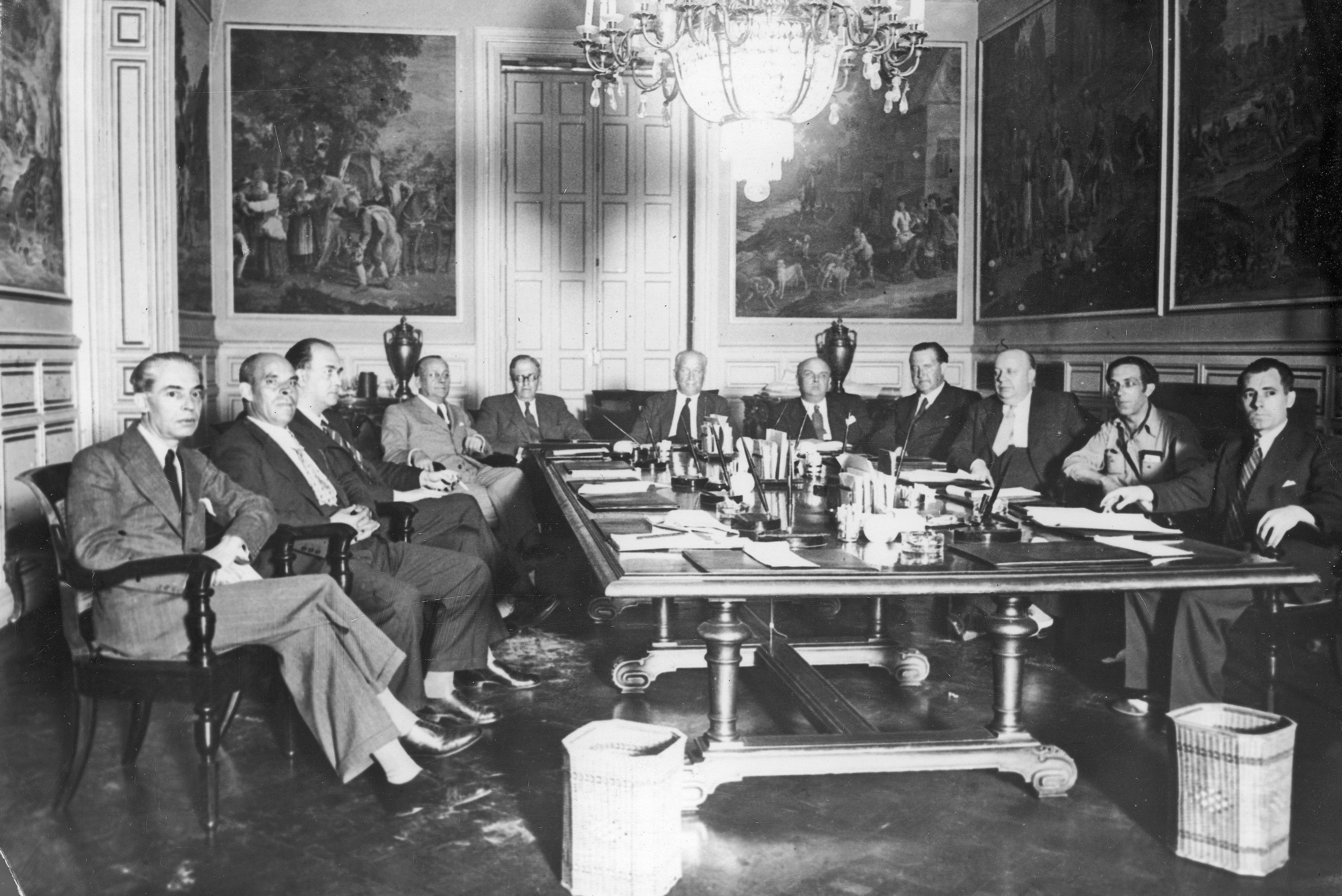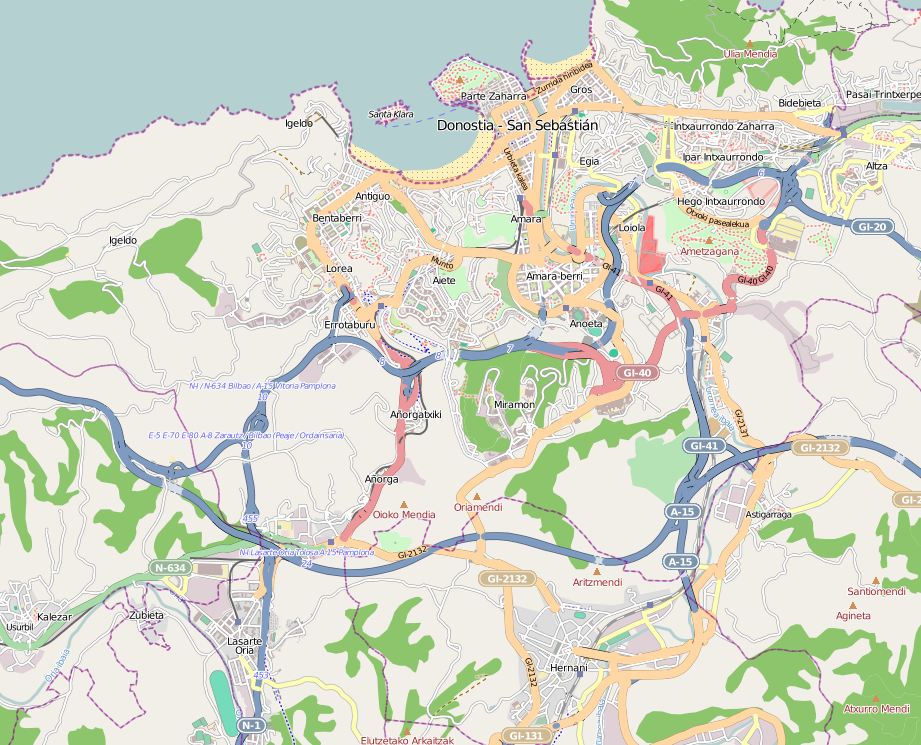|
Statute Of Autonomy Of The Basque Country Of 1936
{{Spain-hist-stub ...
The Statute of Autonomy of the Basque Country of 1936 (; ) was the first statute of autonomy of the Basque Country. It was approved by the Cortes Generales of the Second Spanish Republic on 1 October 1936 in Valencia, in the midst of the Spanish Civil War. After the approval of the Statute, the first autonomous government was formed, led by José Antonio Aguirre (EAJ-PNV) and with the participation of the PSOE, PCE, EAE-ANV, Republican Left and Republican Union. Timeline References 1936 in the Basque Country (autonomous community) 1936 Events January–February * January 20 – The Prince of Wales succeeds to the throne of the United Kingdom as King Edward VIII, following the death of his father, George V, at Sandringham House. * January 28 – Death and state funer ... [...More Info...] [...Related Items...] OR: [Wikipedia] [Google] [Baidu] |
Estella-Lizarra
Estella (Spanish language, Spanish) or Lizarra (Basque language, Basque) is a town located in the autonomous community of Navarre, in northern Spain. It lies south west of Pamplona, close to the border with La Rioja (autonomous community), La Rioja and Álava. The town was founded in 1090 when the place, lying by the fortified settlement of Lizarra, was granted a charter by the Pamplonese king Sancho Ramirez. The town became a landmark in the Way of St. James pilgrimage route to Santiago de Compostela, thriving on the privileged location and the melting pot of ''Francos'' called in by Navarrese kings (mainly Occitan language#Occitan in Spain, Occitans from Auvergne and Limousin), Jews and the original Basque people, Navarrese inhabitants. The wealth resulted in a development of Romanesque architecture, well represented in the town: Church of San Pedro de la Rúa, Palacio de los Reyes de Navarra (Estella), Palacio de los Reyes de Navarra, Church of San Miguel, among others. Histori ... [...More Info...] [...Related Items...] OR: [Wikipedia] [Google] [Baidu] |
Nationalist Faction (Spanish Civil War)
The Nationalist faction (), also Rebel faction () and Francoist faction () was a major faction in the Spanish Civil War of 1936 to 1939. It was composed of a variety of Right-wing politics, right-leaning political groups that supported the Spanish Coup of July 1936 against the Second Spanish Republic and Republican faction (Spanish Civil War), Republican faction and sought to depose Manuel Azaña, including the Falange Española de las JONS, Falange, the Spanish Confederation of the Autonomous Right, CEDA, and two rival monarchist claimants: the Alfonsism, Alfonsist Renovación Española and the Carlist Traditionalist Communion. In 1937, Unification Decree (Spain, 1937), all the groups were merged into the FET y de las JONS. After the death of the faction's early leaders, General Francisco Franco, one of the members of the 1936 coup, headed the Spanish nationalism, Nationalists throughout most of the war, and emerged as the Francoist Spain, dictator of Spain until his death in 197 ... [...More Info...] [...Related Items...] OR: [Wikipedia] [Google] [Baidu] |
Elgeta
Elgeta () is a town located in the province of Gipuzkoa, in the autonomous community of Basque Country, northern Spain Spain, or the Kingdom of Spain, is a country in Southern Europe, Southern and Western Europe with territories in North Africa. Featuring the Punta de Tarifa, southernmost point of continental Europe, it is the largest country in Southern Eur .... References External linksOfficial websiteELGETA at the Bernardo Estornés Lasa - Auñamendi Encyclopedia (Euskomedia Fundazioa) Municipalities in Gipuzkoa Debagoiena {{basque-geo-stub ... [...More Info...] [...Related Items...] OR: [Wikipedia] [Google] [Baidu] |
Spanish Names Of The Basque Country
In the Spanish public discourse the territory traditionally inhabited by the Basques was assigned a variety of names across the centuries. Terms used might have been almost identical, with hardly noticeable difference in content and connotation, or they could have varied enormously, also when consciously used one against another. The names used demonstrate changing perceptions of the area and until today the nomenclature employed could be battleground between partisans of different options. List of names used The below list contains names applied in Spanish cultural realm to the territory traditionally inhabited by the Basques. Terms originating from other languages (first of all Basque, though also Latin) are acknowledged if in circulation also in Spanish. The list contains indisputably proper names (e.g. "Provincias Vascongadas"), names with unclear or varying usage (e.g. "Provincias Exentas" or "provincias exentas") and names which have never acquired the status of a proper nam ... [...More Info...] [...Related Items...] OR: [Wikipedia] [Google] [Baidu] |
Indalecio Prieto
Indalecio Prieto Tuero (30 April 1883 – 11 February 1962) was a Spanish politician, a minister and one of the leading figures of the Spanish Socialist Workers' Party (PSOE) in the years before and during the Second Spanish Republic. Less radical than Francisco Largo Caballero, Prieto served as minister under his government during the Spanish Civil War. Exiled in Mexico after the republican defeat, he led the Socialist Party from 1948 to 1951. Early life Born in Oviedo in 1883, he was six years old when his father died. His mother moved him to Bilbao in 1891. From a young age, he survived by selling magazines in the street. He eventually obtained work as a stenographer at the daily newspaper ''La Voz de Vizcaya'', which led to a position as a copy editor and later a journalist at the rival daily '' El Liberal.'' He eventually became the director and owner of the newspaper. In 1899, at the age of 16, he had joined the PSOE. As a journalist in the first decade of the 20th cent ... [...More Info...] [...Related Items...] OR: [Wikipedia] [Google] [Baidu] |
Popular Front (Spain)
The Popular Front () was an electoral alliance and pact formed in January 1936 to contest that year's general election by various left-wing political organizations during the Second Spanish Republic. The alliance was led by Manuel Azaña. In Catalonia and the modern-day Valencian Community, the coalition was known as the Front of the Lefts (). The Popular Front included the Spanish Socialist Workers' Party (PSOE), Communist Party of Spain (PCE), and the republicans: Republican Left (IR), (led by Azaña) and Republican Union (UR), led by Diego Martínez Barrio. This pact was supported by Galician ( PG) and Catalan nationalists ( ERC), the POUM, socialist union Workers' General Union (UGT), and the anarchist trade union, the Confederación Nacional del Trabajo (CNT). Many anarchists who would later fight alongside ''Popular Front'' forces during the Spanish Civil War did not support them in the election, urging abstention instead. The Comintern had decided in 1935 ... [...More Info...] [...Related Items...] OR: [Wikipedia] [Google] [Baidu] |
1936 Spanish General Election
Legislative elections were held in Spain on 16 February 1936. At stake were all 473 seats in the unicameral Cortes Generales. The winners of the 1936 elections were the Popular Front, a left-wing coalition of the Spanish Socialist Workers' Party (PSOE), Republican Left (Spain) (IR), Esquerra Republicana de Catalunya (ERC), Republican Union (UR), Communist Party of Spain (PCE), Acció Catalana (AC), and other parties. Their coalition commanded a narrow lead over the divided opposition in terms of the popular vote, but a significant lead over the main opposition party, Spanish Confederation of the Autonomous Right (CEDA), in terms of seats. The election had been prompted by a collapse of a government led by Alejandro Lerroux, and his Radical Republican Party. Manuel Azaña would replace Manuel Portela Valladares, caretaker, as prime minister. The electoral process and the accuracy of the results have been historically disputed. Some of the causes of this controversy include ... [...More Info...] [...Related Items...] OR: [Wikipedia] [Google] [Baidu] |
1933 Spanish General Election
Elections to Spain's legislature, the Cortes Generales, were held on 19 November 1933 for all 473 seats in the unicameral Cortes of the Second Spanish Republic. Since the 1931 Spanish general election, previous elections of 1931, a Spanish Constitution of 1931, new constitution had been ratified, and the Suffrage, franchise extended to more than six million women. The governing Republican-Socialist coalition had fallen apart, with the Radical Republican Party beginning to support a newly united political right. The right formed an electoral coalition, as was favoured by the new electoral system enacted earlier in the year. The Spanish Socialist Workers' Party (''Partido Socialista Obrero Español'', or PSOE) won only 59 seats. The newly formed Roman Catholic Church, Catholic conservative Spanish Confederation of the Autonomous Right (''Confederación Española de Derechas Autónomas'' or CEDA) gained 115 seats and the Radicals 102. The right capitalised on disenchantment with th ... [...More Info...] [...Related Items...] OR: [Wikipedia] [Google] [Baidu] |
1933 Basque Statute Of Autonomy Referendum
A statutory referendum on the approval of the Basque Statute of Autonomy was held in the Basque Country on Sunday, 5 November 1933. Voters were asked whether they ratified a proposed draft Statute of Autonomy of the Basque Country. Article 12 of the Spanish Constitution of 1931 allowed for Spanish provinces to be organized into "autonomous regions", provided that a regional Statute was proposed by a majority of the provinces' municipalities comprising at least two-thirds of the provincial population and that two-thirds majority of all those eligible to vote accepted the draft Statute. The referendum was the first after the introduction of women's suffrage. The referendum resulted in 97% of valid votes in support of the draft Statute on a turnout of 94%, representing 84% of the electorate. The percentage of registered voters voting ''yes'' were 46% in the province of Álava (due to boycott from carlists), 90% in the province of Gipuzkoa and 88% in the province of Biscay. In larg ... [...More Info...] [...Related Items...] OR: [Wikipedia] [Google] [Baidu] |
Vitoria-Gasteiz
Vitoria-Gasteiz (; ; also historically spelled Vittoria in English) is the seat of government and the capital city of the Basque Country (autonomous community), Basque Country and of the provinces of Spain, province of Álava in northern Spain. It holds the autonomous community's Basque Parliament, House of Parliament, the headquarters of the Government, and the Lehendakari, Lehendakari's (Prime Minister's) official residency. The municipality—which comprises not only the city but also the mainly agricultural lands of 63 villages around—is the largest in the Basque Country, with a total area of , and it has a population of 261,494 (January 2025). The dwellers of Vitoria-Gasteiz are called ''vitorianos'' or ''gasteiztarrak'', while traditionally they are dubbed ''babazorros'' (Basque language, Basque for 'bean sacks'). Vitoria-Gasteiz is a dynamic city with strengths in healthcare, aeronautics, the automotive industry, and viticulture. It is the first Spanish municipality to be ... [...More Info...] [...Related Items...] OR: [Wikipedia] [Google] [Baidu] |
San Sebastián
San Sebastián, officially known by the bilingual name Donostia / San Sebastián (, ), is a city and municipality located in the Basque Autonomous Community, Spain. It lies on the coast of the Bay of Biscay, from the France–Spain border. The capital city of the province of Gipuzkoa, the municipality's population is 188,102 as of 2021, with its metropolitan area reaching 436,500 in 2010. Locals call themselves ''donostiarra'' (singular) in Basque, also using this term when speaking in Spanish. It is also a part of Basque Eurocity Bayonne-San Sebastián. The economic activities in the city are dominated by the service sector, with an emphasis on commerce and tourism, as San Sebastián has long been well-known as a tourist destination. Despite the city's relatively small size, events such as the San Sebastián International Film Festival and the San Sebastian Jazz Festival have given it an international dimension. San Sebastián, along with Wrocław, Poland, was the Eur ... [...More Info...] [...Related Items...] OR: [Wikipedia] [Google] [Baidu] |



